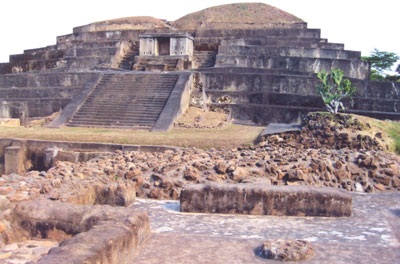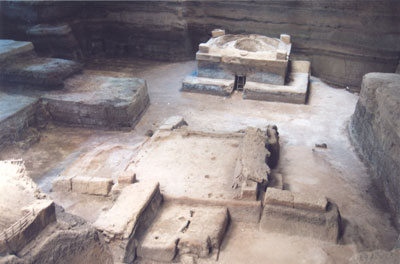El Salvador’s pre-Columbian past
This item appears on page 69 of the August 2009 issue.
by Julie Skurdenis
(First of two parts)
El Salvador, the smallest of the seven countries comprising Central America, is part of Mesoamerica, the cultural entity stretching from mid-Mexico to mid-Central America.
The earliest hunter-gatherer Mesoamericans migrated from Asia across the Bering Strait probably between 10,000 and 15,000 years ago. By the third millennium BC they had become agriculturists. From that point on, the population expanded, cities developed and trade flourished.
By the time Pedro de Alvarado and the Spanish conquistadores arrived in El Salvador in 1534, most of the great urban centers they had built had already seen their heyday and declined. At the time of the arrival of the Spaniards, there were Pipils living there, descendants of Aztec and Toltec peoples who had migrated to El Salvador after the collapse of the Maya empire around AD 900.
On a trip to El Salvador in January ’09, my husband, Paul, and I visited five of the country’s six major pre-Columbian archaeological sites: Joya de Cerén, San Andrés, Tazumal, Casa Blanca and Cihuatán. The only one we missed was Quelepa in eastern El Salvador. Too much to see, too little time.
America’s Pompeii
Joya de Cerén, located 22 miles northwest of the capital, San Salvador, is El Salvador’s only UNESCO World Heritage Site. It deserves this honor. There’s a sign at the site stating that Joya de Cerén offers a “unique window to understanding life in a prehispanic village.”
Joya de Cerén, one of perhaps 250 small Maya communities that flourished in the Zapotitan Valley in the sixth and seventh centuries AD, was buried by volcanic ash from the eruption of Laguna Caldera sometime around AD 640. An average of 20 feet of ash covered the village, freezing it in time.
No human remains have been found in what has been dubbed “America’s Pompeii,” indicating that the inhabitants had enough warning to run for their lives. They did, however, leave everything behind: tools, household utensils, food still uneaten in bowls, and plants in kitchen gardens.
Visitors can walk through three separate areas protected by roofs, viewing houses built of adobe brick or wattle and daub. Most are divided into compact living/bedrooms, kitchen and storage areas.
There’s also a shaman’s dwelling with an intricate exterior design and a sweat house similar to the kivas used by the Indians of the southwest US. The layers of ash preserved them all. The Pipils who repopulated the area much later, sometime after AD 900, probably never realized they were living atop a buried community.
The on-site museum was still being renovated at the time of our visit. Joya de Cerén and the other archaeological sites we visited in El Salvador all have the same opening hours: 9 to 4, Tuesday to Sunday. Admission costs $3 for non-Salvadorans.
Ceremonial center
Joya de Cerén was one of many communities surrounding the ceremonial center of San Andrés, only two miles away. San Andrés’ roots may go back as far as 900 BC, but it flourished between AD 600 and 900 as both a ceremonial and administrative center for the surrounding communities.
Atop an acropolis was the Great Plaza surrounded by temples, palaces and pyramids, some encasing royal tombs. It all was abandoned around AD 900, part of the general Maya collapse.
San Andrés is an atmospheric place to visit, with many mounds, including the as-yet-unexcavated main pyramid, La Campana, still covered by grass and earth. But you can walk across the Great Plaza, past an impressive partially excavated pyramid, and view the layers of construction, one over the other, of a structure adjacent to this pyramid.
Monumental Tazumal
Arguably, Joya de Cerén is El Salvador’s most important archaeological site. Tazumal is its most spectacular, a picture-postcard-perfect sort of place and — like all the archaeological sites we visited in El Salvador — easy to see without becoming exhausted from the sheer size of the place.
Tazumal is located 50 miles northwest of San Salvador, and its origins go back to about 1200 BC when the first settlements were built in the area. It grew into both a ceremonial and trading center in contact with other Mesoamerican groups — Maya, Olmec, Teotihuacano and Toltec — during its long history.
The most important pyramid at Tazumal is the unimaginatively named B 1.1. Rising 75 feet, this huge pyramid is actually at least five pyramids constructed at different times one atop the other, most dating from the Middle Classic period (AD 400-600).
A temple once crowned the top of the pyramid, although another, smaller temple can still be seen on the pyramid’s west side, rather unusual in its placement halfway up the pyramid. On the south side of the pyramid is a ball court that seems to have been part of the pyramid itself.
Also unusual in its placement close to pyramid B 1.1 is pyramid B 1.2. It rises in tiers and was constructed hundreds of years after B 1.1 during the Post Classic period between AD 800 and 1200, probably by Toltecs from Mexico or a group influenced by Toltecs.
There’s an excellent on-site museum with a huge boulder outside incised with an Olmec-style warrior. The boulder dates from the Pre-Classic period (900-400 BC) and was moved from a nearby site.
Next door to Tazumal is a much older site, Casa Blanca, built in the Late Classic period (400 BC-AD 250). In a shady setting stand several partially excavated pyramids that once stood on a huge platform, 730 feet by 800 feet, that now lies several yards beneath the ground. When we visited, the on-site museum was closed due to a lack of funds.
If you go. . .
For four of our 12 days in El Salvador we had a private guide, Jorge Drago (phone 011 503 72 104242 or e-mail jorgedrago19@yahoo.com), whom we recommend highly. He drove us to and guided us around most of the archaeological sites we visited and also along the Ruta de las Flores, the string of colonial villages west of San Salvador.
He charges $50 per person for tours inside or near San Salvador and $100 per person for tours outside San Salvador.
Coming up: Cihuatán.


